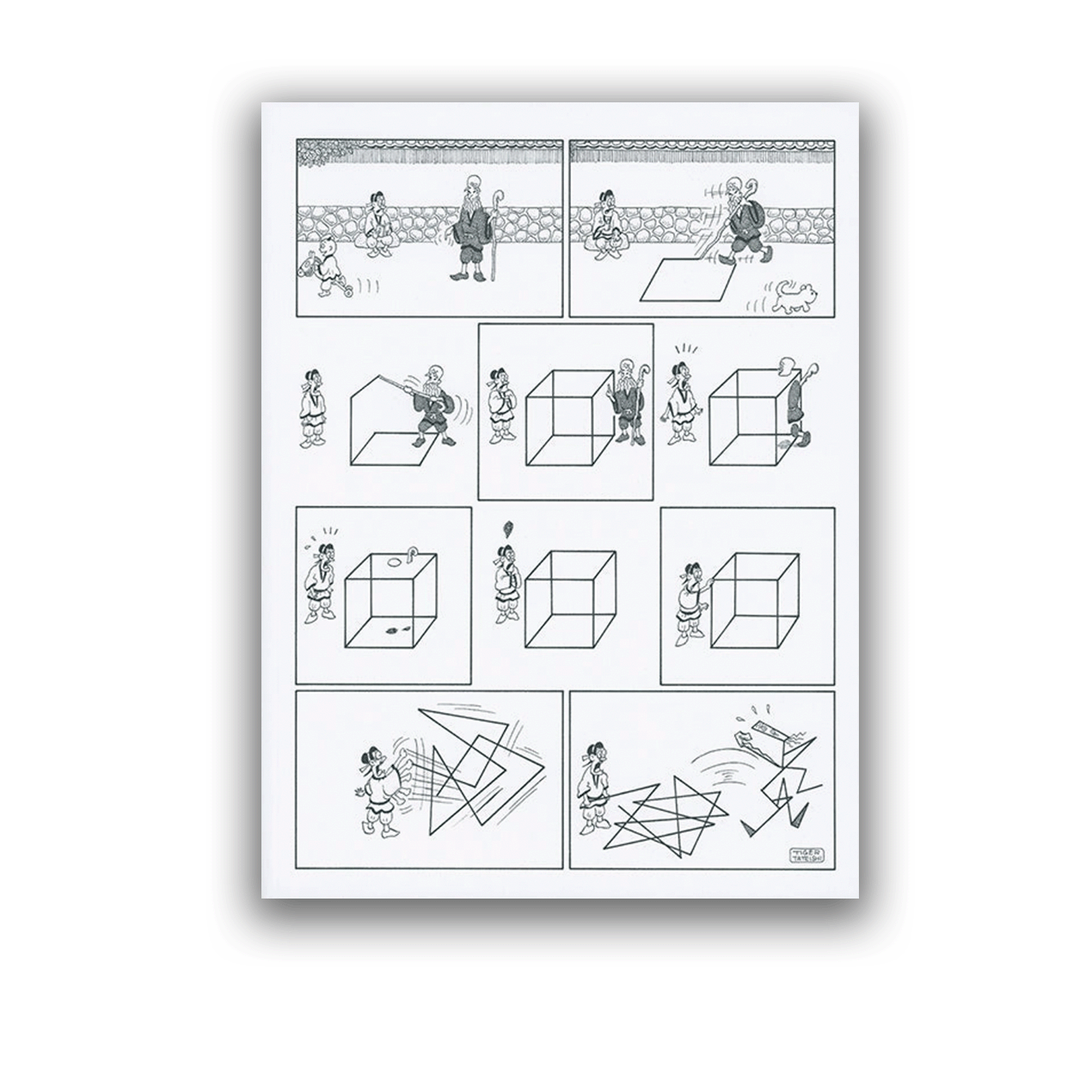Cheat Sheets – Tiger Tateishi
Cheat Sheets is a new edition of Tiger Tateishi’s incredible 1982 comics collection.
Tiger Tateishi first began drawing cartoons in 1964, inspired by copies of MAD Magazine which occupation forces had left behind. Before moving to Milan in 1969, Tateishi regularly contributed to manga magazines. In Milan, while working for Ettore Sottsass at Olivetti, he began creating the stunning comic panel layout paintings posthumously collected in the book Moon Trax. Also around this time, as Fumiko Tateishi explains, Tiger “had a strong desire to make a real comic book, and spent almost five years working on the pictures for Tora No Maki [presented here as Cheat Sheets]. At first, Penguin Books in London were considering publishing it, and they had the originals for quite a while, but after a call from Seigow Matsuoka at Kousakusha in Tokyo, the book was eventually brought out in Japan.”
Cheat Sheets presents these comics in a single volume for the first time outside of Japan. Welcome to the strange world of the hermit Arara Sennin.
(For those who have purchased the book, here is a PDF which includes the titles of the comics.)
***
“Tiger Tateishi was a master cartoonist and this book is proof of that–each page presents genius explorations on the medium that will blow your mind with just simple black lines. I’m so excited this book was published because finding these comics is pretty much impossible now a days. Super recommended!” — Inés Estrada, the excellent cartoonist who sells the book at her Gato Shop
“A special treat for the comics æsthete!… Read once for fun. Read again to ponder the illusory nature of reality. Then read (at least) one more time to study how Tateishi does it.”–Copacetic Comics
“In terms of manga reprinted for the American market, one might recommend these strips to fans of Maki Sasaki or Shigeru Sugiura, although I think Tateishi’s nonsense is far more approachable. Like Abner Dean, Tateishi is someone whose work I first encountered on an internet where images could easily be shared, that blew my mind with how out of time they seemed. Here is a psychedelia looking for a good time outside the constraints of language… In a Tateishi comic, a shape or an animal, is merely the line that defines it. It can be translucent, and rearranged. Even the horizon line can be pulled like a piece of string. To exist on the image plane is to be subject to being rearranged, discombobulated. The world of drawing can be redrawn. It is a game of a particular sort: wherever there are rules, someone can cheat, and at the end of the day—which might well be one of those sunsets where the sun rolls off like a gear—Tiger Tateishi wins.”–Brian Nicholson, The Comics Journal
***
Tiger Tateishi, from a 1976 letter to SD Magazine: “Here in Milan, the hustle and bustle before Christmas and the fog are creating a special atmosphere. Apart from my work as a painter and illustrator, I have started doing cartoons again and am currently laboring away on those. All of them are very short pieces of a single page or at most three, and when I have accumulated 60 or 70 pages or so, I plan to start looking for a publisher in the UK or perhaps the Netherlands.”
***
Fumiko Tateishi, as quoted in Moon Trax: “Around that time [1964], old issues of the American satirical magazine MAD, which the occupation forces had left behind, were popping up in second hand bookstores. I got hold of a copy and showed it to Tateishi, who found it hysterically funny. When he was a kid, he had always wanted to be a designer or an artist or a cartoonist, he said. From the end of 1964, he started drawing cartoons in earnest […] In 1968, he published The Collected Cartoons of Tiger Tateishi at his own expense, and some of those pieces also appeared in the French magazine Plexus. He also encountered Kunio Nagatani and Fujio Akatsuka, and began drawing for the magazine Manga No. 1, which Akatsuka had launched, and he was busy working with Akatsuka and his friends for Shonen Sunday and other magazines as well.”
***
About the author: Kōichi “Tiger” Tateishi worked in a variety of media including comic books, illustrated books, painting, sculpture, and ceramics during his prolific career. Inspired by science fiction, including Robert Sheckley’s early stories, his enigmatic works explored reality and its limitations. In 1966, his work was featured in the acclaimed 15th Yomiuri Independent Exhibition. In 1969, Tateishi relocated to the city of Futurism, Milan in Italy, and began working in the studio of Ettore Sottsass, bringing the ideas of the architect and designer to life. During this time, Tateishi’s personal artwork moved closer to visual narratives as he made several oil tableaux infused with science-fiction themes. Upon his return to Japan in 1982, he produced daily comics embracing the nonsense genre. Tiger Tateishi passed away at only 56 years of age, but is fondly remembered for the zest and energy of his mind-bending works, which invigorated the Japanese pop-art scene.
$48.00
Only 1 left in stock





 Admin Admin
Admin Admin  Architectures of Healing
Architectures of Healing
 Bodies of Extraction
Bodies of Extraction












